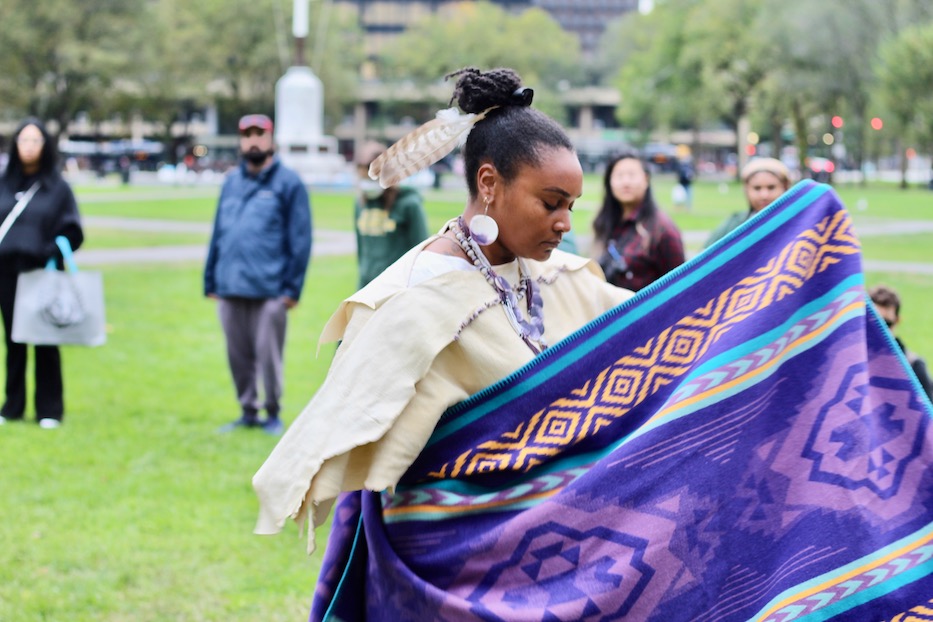
Music | Arts & Culture | New Haven Green | Arts, Culture & Community | Indigenous rights | Arts & Anti-racism
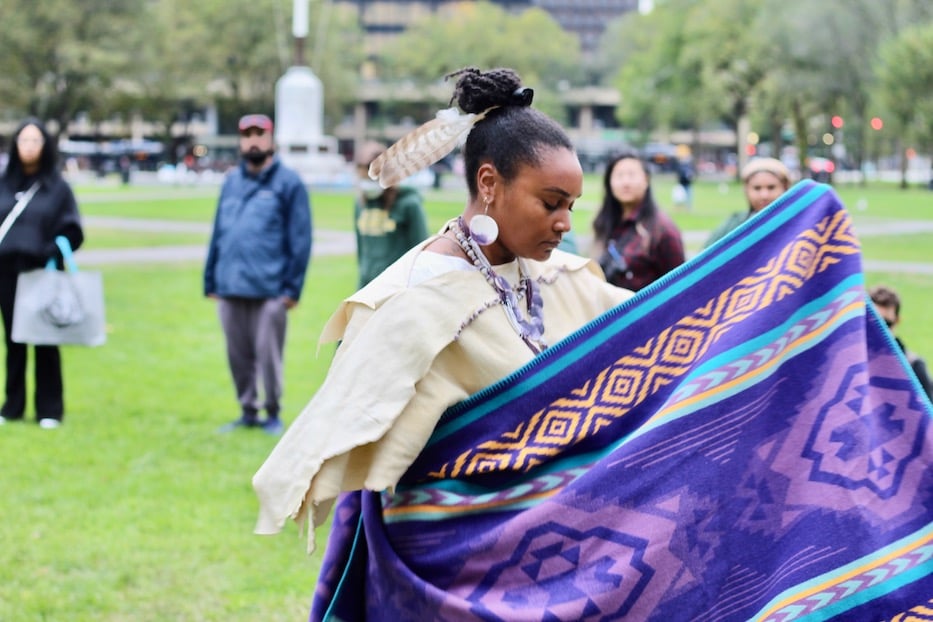
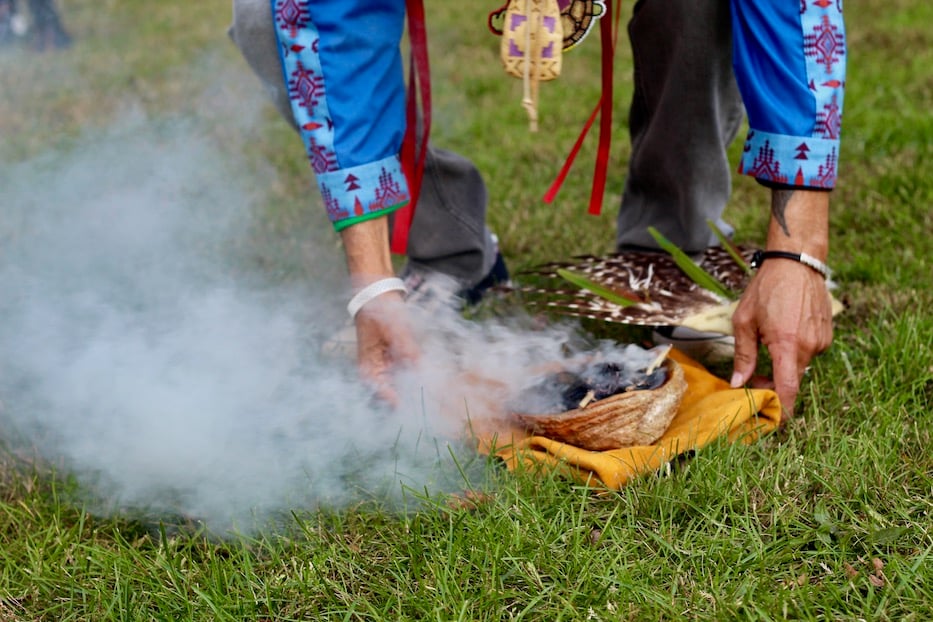
Top: Rawlings steps forward to offer the Blanket Dance. Bottom: Clement with the sage, which at one point spontaneously caught fire. Lucy Gellman Photos.
The sound of drums coasted over the New Haven Green, mingling with the scent of sage still in the air. Overhead, the sky had started to darken; gulls circled low overhead. Stepping into a circle, Jennifer Rawlings held out the thick purple blanket that had been keeping her warm, extended a deerskin-clad leg, and began to move.
Monday, Rawlings and her son, Dyami Pimentel, joined close to 50 people observing Indigenous Peoples’ Day on the Green, which sits on unceded Quinnipiac land across from New Haven’s City Hall. Organized by longtime activist Norm Clement, this year’s gathering made space for Indigenous storytelling, culture and ceremony across cultural and geographic borders, addressing colonialism as both an ongoing problem and source of deep generational trauma.
Attendees also took time to remember Mi’kmaq member Sadé Heart of the Hawk Ali, a frequent attendee who passed away in November 2022.
“I hope we're bringing some love and community here today,” said Clement, who is a water protector, confederate member of the Quinnipiac tribe and a member of the Penobscot nation. “We are still here. They've tried for [over] 500 years to get us, but we’re still here."
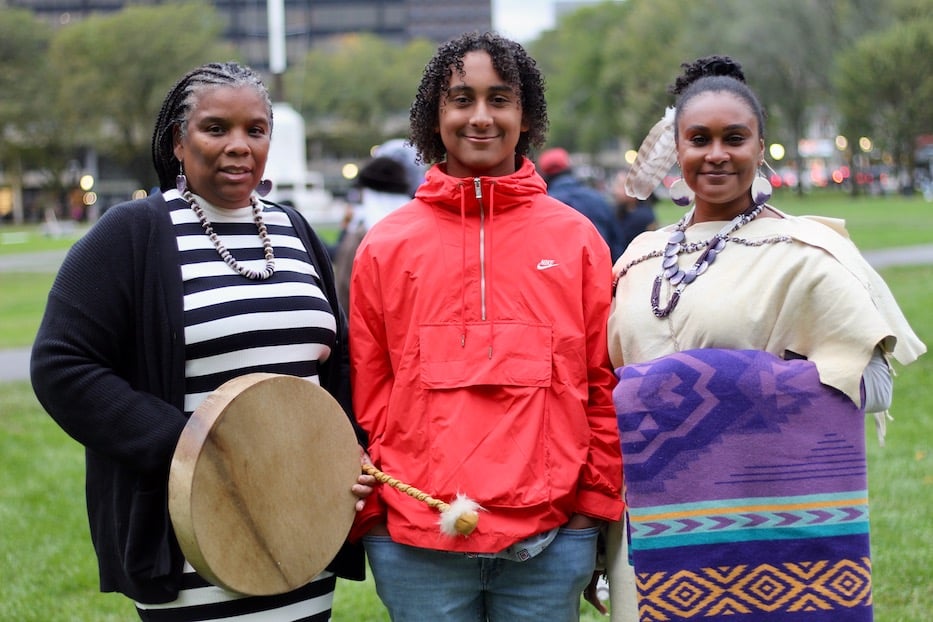
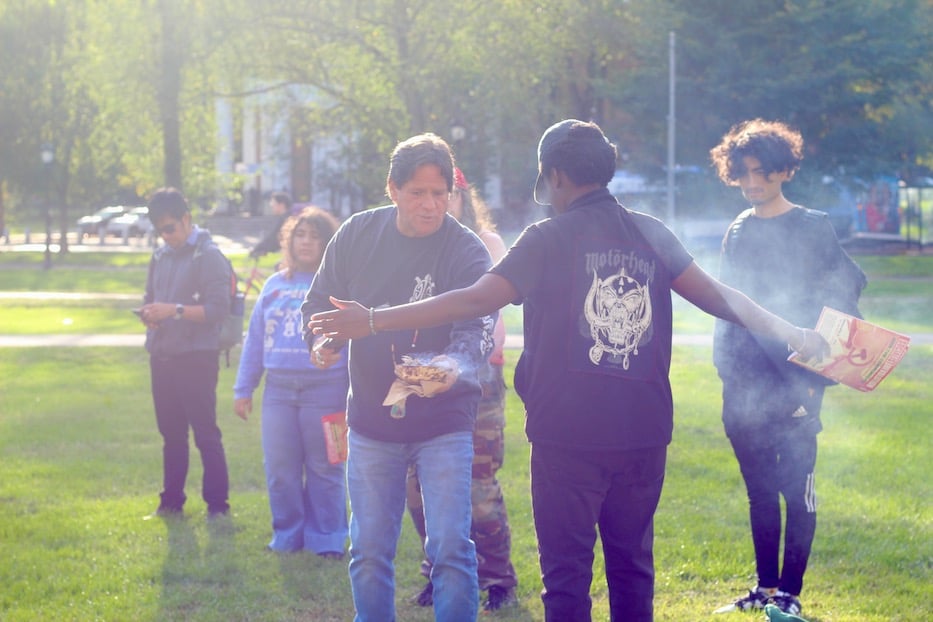
Top: Dr. Tamiko Jackson-McArthur, Dyami Pimentel and Jennifer Rawlings. Bottom: Ricky Looking Crow, who is a member of the Passamaquoddy Tribal Nation.
This year, he said, his hope for greater Indigenous recognition—and an official end to sharing the day with Christopher Columbus—has felt especially raw as he watches violence unfold between Israel and Palestine abroad and at home. Directly before Monday afternoon's gathering, he and several others attended a rally for Palestinian rights in front of City Hall, often speaking over Israeli counter-protesters who showed up with blue-and-white flags, a speaker system and music.
"We want to get rid of that colonizer [Columbus] the same way that folks who are supporting Palestine want to get rid of their colonizers," he said. He did not condone the weekend's violence, but focused instead on how difficult and painful it is to survive under centuries of oppression.
Monday, that sense of solidarity was everywhere, from attendees who came straight from the rally to those who shared stories of growing up Indigenous in New Haven, in Connecticut and across the country. As Clement filled a polished abalone shell with sage, fanning it with a turkey feather, Rawlings stepped in close, listening to details about the ceremony to come.
A proud member of the Wampanoag Tribe, Rawlings grew up in New Haven, taught by her parents to be proud of her Indigenous heritage. As a girl, she attended powwows and ceremonies across the Northeast, an upbringing for which she is now "very, very grateful," she said. When her teachers at Edgewood School failed to teach Native history, her parents offered to be a resource for the school.
Now, she does the same thing for her son, who attends Worthington Hooker School in the city’s East Rock neighborhood.
"I bring representation of the original people, of this land," she said. While the Wampanoag are further North, "we certainly traveled these lands and these waters. I come out here and I put on my full regalia to show people we're still here."
As she spoke, she motioned to her clothing, a deerskin dress with white-and-purple wampum shell jewelry and hawk feathers, "from our relatives who are winged and four-legged." When she comes dressed in regalia, she said, it is to remind both herself and those around her "that we rely on each other," from the clams and oysters that filter nitrogen from the water to the traditional mishoon used for Wampanoag travel.
Standing quietly beside her for most of the afternoon, Pimentel added that he was grateful to bring representation of fellow native people to the Green.
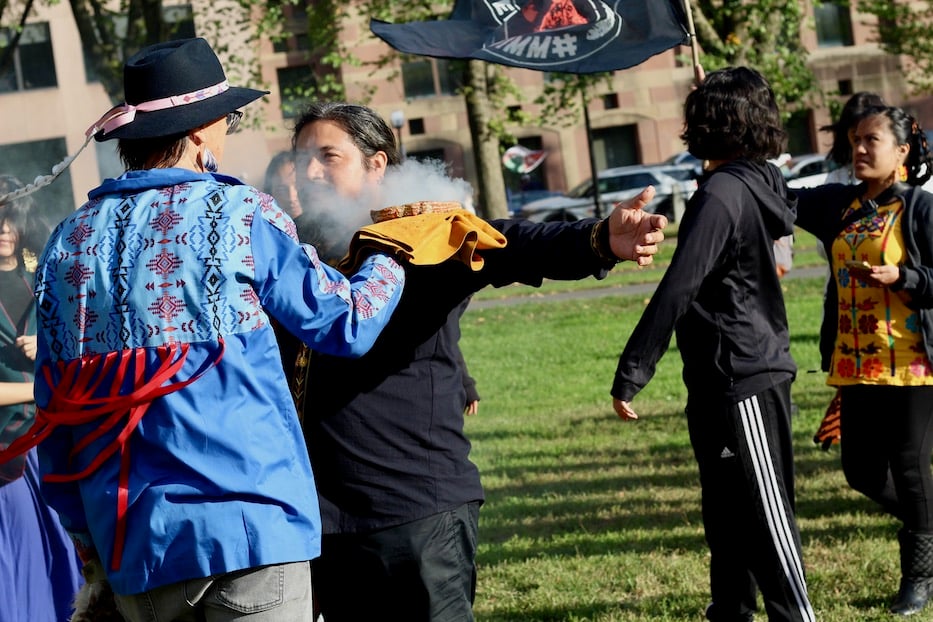
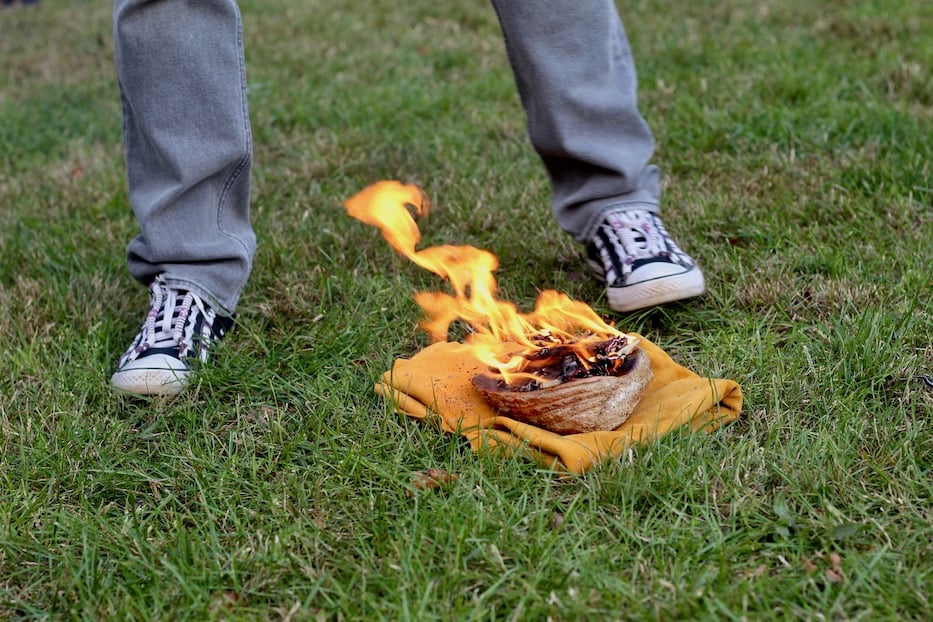
Clement during the smudging ceremony with Semilla Collective member Erick Sarmiento.
Around her, the smell of sage floated up over the Green, its white wisps like long, fragrant fingertips in the cooling air. With Ricky Looking Crow, a member of the Passamaquoddy Tribal Nation who has attended for years, Clement motioned for attendees to line up for a smudging ceremony. As he and Looking Crow worked, shell and burning sage in one hand and turkey feather in the other, he stressed the importance of beginning with the ritual, to clear the space and the bodies within it “of all the bad energy.”
As he stood watching with members of the Semilla Collective, Yale University freshman Pablo Macias Lopez said that the spirit of the day resonated with him across cultural and geographic borders. Macias Lopez, who grew up in Las Vegas, is Wixárika, one of the oldest known and surviving Indigenous peoples in Mexico. When he was just a baby, his family fled government persecution in Aguascalientes, Mexico, immigrating to the U.S. for a safer life.
Having grown up displaced from his ancestral home, "it's super important for me to be in community with Indigenous people," he said. In Mexico, thousands of members of the Wixárika are currently fighting to take back Native land that farmers and ranchers purchased the title to in the 20th century and have cultivated for decades. Monday afternoon, Macias Lopez had come over to the Indigenous Peoples' Day observance after attending the rally across the street.
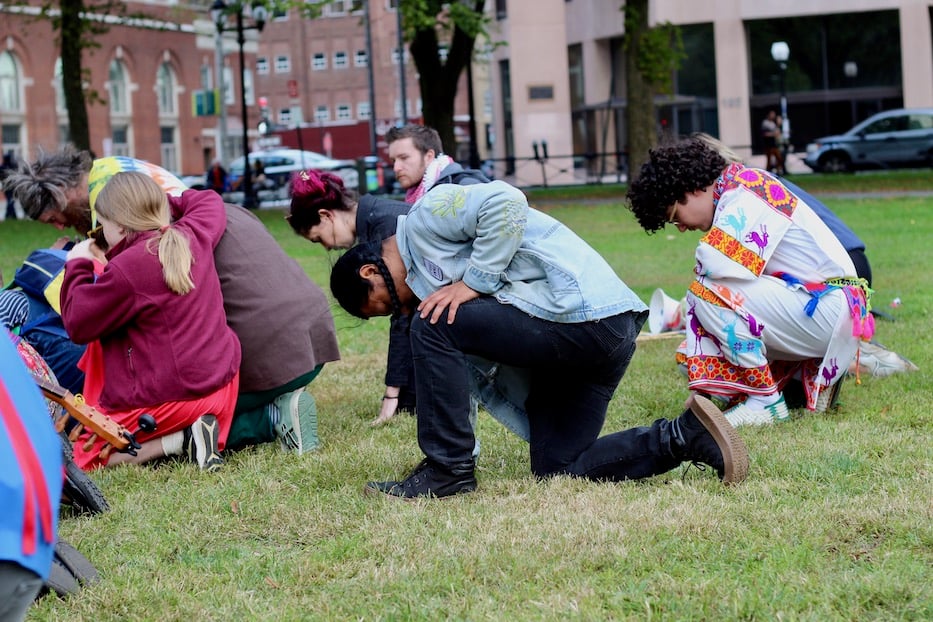
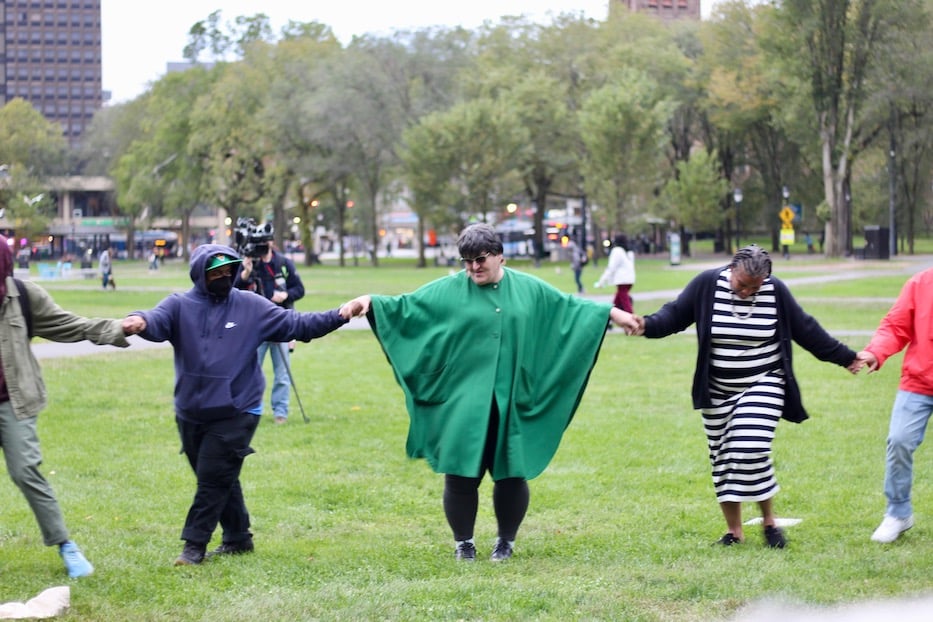
A few feet away, Clement led attendees in a prayer to each of the four cardinal directions, guiding them through each as they formed a wide circle, and rotated towards the almost-setting sun. Despite low-hanging clouds over the Green, a few rays poked through, dripping bright light as if they were listening closely for Clement's voice. When he reached his gratitude for Mother Earth, those in the circle sank down onto their knees, hands in the grass.
In the moment, Clement's voice broke through the shouting matches across the street, the rumbling of cars and buses making their way through the streets, another event at the corner of the Green, where a knot of people stood in matching purple t-shirts. His message—of how connected humans are to the earth, to the air, to the wide sky above—seemed to resonate as attendees listened and nodded.
So too as he called for a moment of silence to remember Sadé Heart of the Hawk, who for decades dedicated her life to suicide prevention, trauma reduction, and education and advocacy for Two-Spirit people. In Connecticut and across the country, she also made it her mission to teach Native and non-Native people about the violent and horrific history of residential schools.
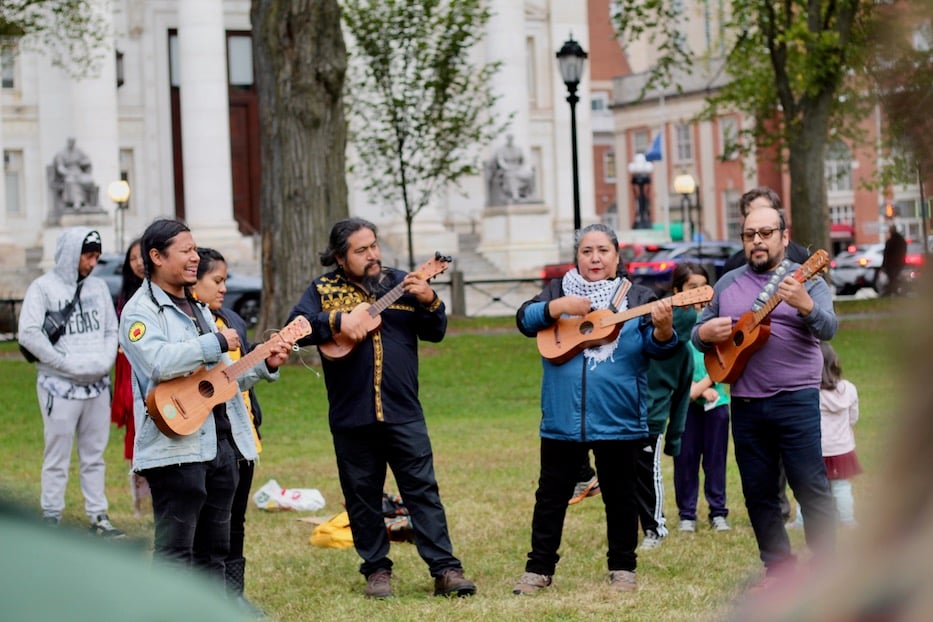
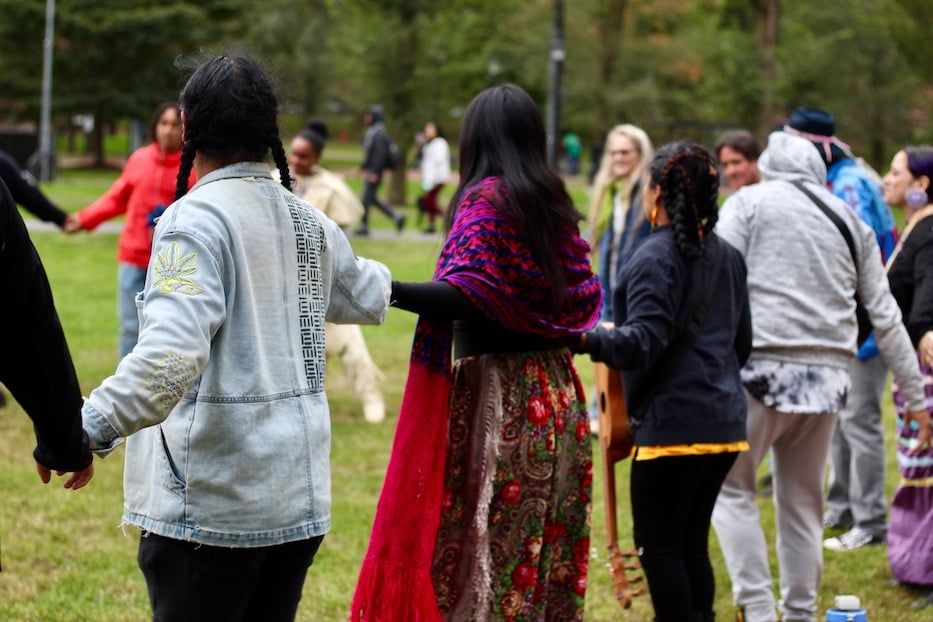
While she spent the final years of her life in North Haven, Clement said Monday, the two did not meet until both were at Standing Rock in 2016 to protest the Dakota Access Pipeline. After they did, she made sure to attend Clement's Indigenous Peoples' Day event on the Green, often there with a song or poem to offer.
"She is now one of our ancestors," Clement said, his voice strained and reverent as Ricky Looking Crow lifted a drum and began to play. For a moment, a hush fell over the circle. After a beat, Rawlings stepped forward with an Eastern Blanket Dance, which Ricky Looking Crow described as a courtship ritual after she finished.
Clement, who has organized the event for the better part of a decade, also invited members of the Semilla Collective to perform, yoking Native narratives and struggles from New Haven to North Dakota to Oaxaca and Veracruz. As Erick Sarmiento and Denise Cruz began to sing, the whole circle joined in, attendees clapping to the sound of jarana and vocals that grew stronger with each word.
"It's what we sing to connect with the ancestors, with the spirits," Sarmiento said before inviting up fellow members of the Semilla Collective to perform a second number. At the far end of the group, musician and activist Javier Villatoro invited people to come in closer, so that it would be easier for them to hear the music.
Listening nearby, pediatrician, New Havener and Nipmuc ambassador Dr. Tamiko Jackson-McArthur said she was grateful for the event, which allowed her to be in community with other Indigenous people. A member of the Nipmuc Nation, Jackson-McArthur grew up in New Haven, learning about the Nipmuc people from her dad.
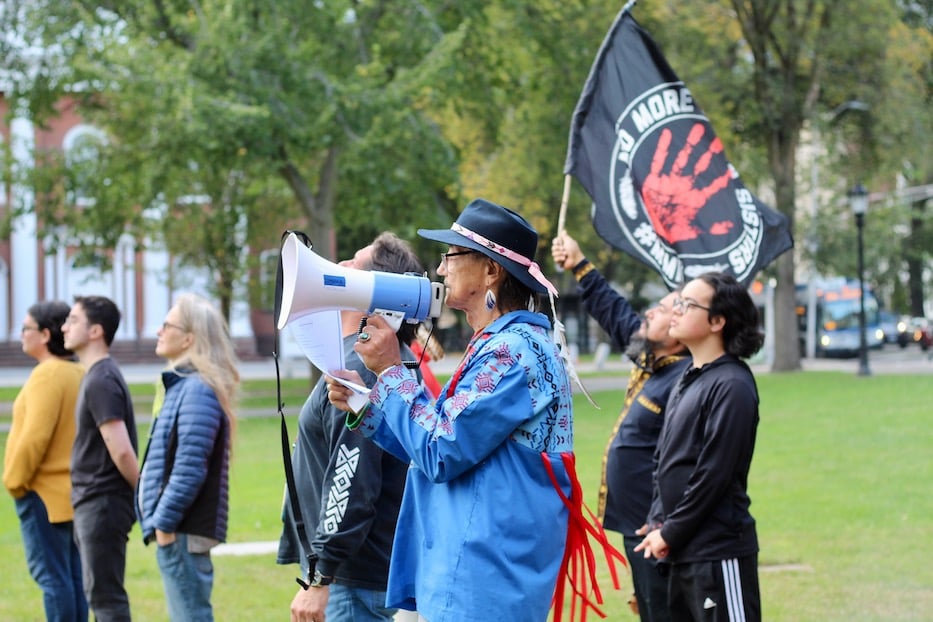
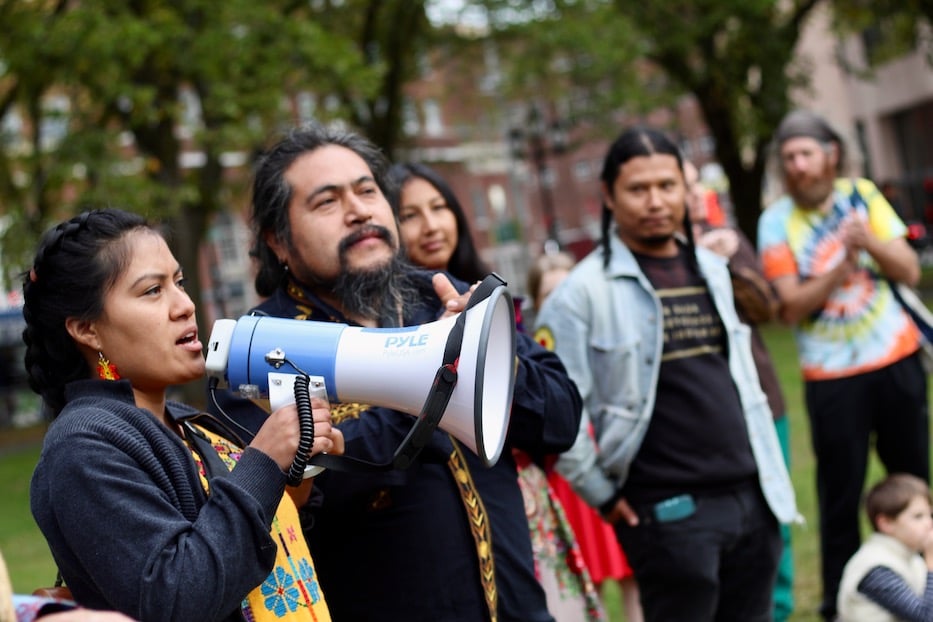
Raised on Front Street, she grew to both love and pass on this history of peaceful freshwater people who had been displaced from their land. Now, she works to educate other people about Native and Nipmuc history.
In the city and the country alike, "I hope that we can have more recognition" going forward, she said. Her words echoed Clement's earlier criticism of the city, where Indigenous people still must share the second Monday in October with Italian American Heritage Day, despite longtime pleas and advocacy from activists, students, and city residents to do away with any remnant of Columbus Day altogether.
Three years ago, Mayor Justin Elicker changed the name of the holiday—but stopped short of recognizing only Indigenous people—in an effort to placate Italian Americans still angry about the removal of a Christopher Columbus statue in Wooster Square park.
Before the observance concluded, Clement and Looking Crow held up a banner that they planned to place at the Knights of Columbus Museum on State Street, a final act of resistance and solidarity on a day they had dedicated to it. From the front of the cloth, a stretched white cotton, a number of red handprints crowded the top register, a reminder of the epidemic of Missing and Murdered Indigenous Women in this country and well beyond it.
500 Years of Genocide/And/We Are Still Here, it read. Beneath the word And, Clement had added two green, white and red Palestinian flags.
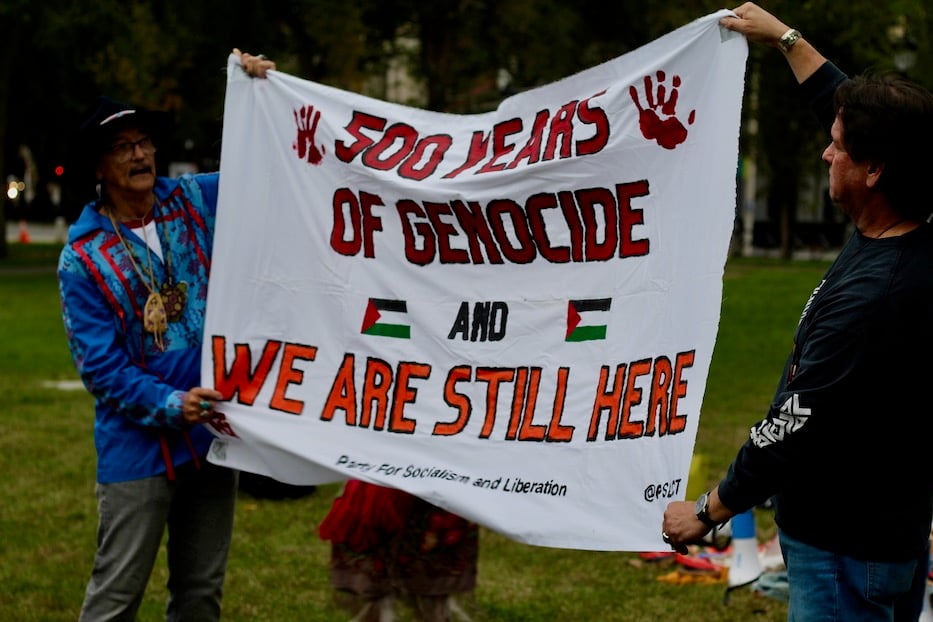
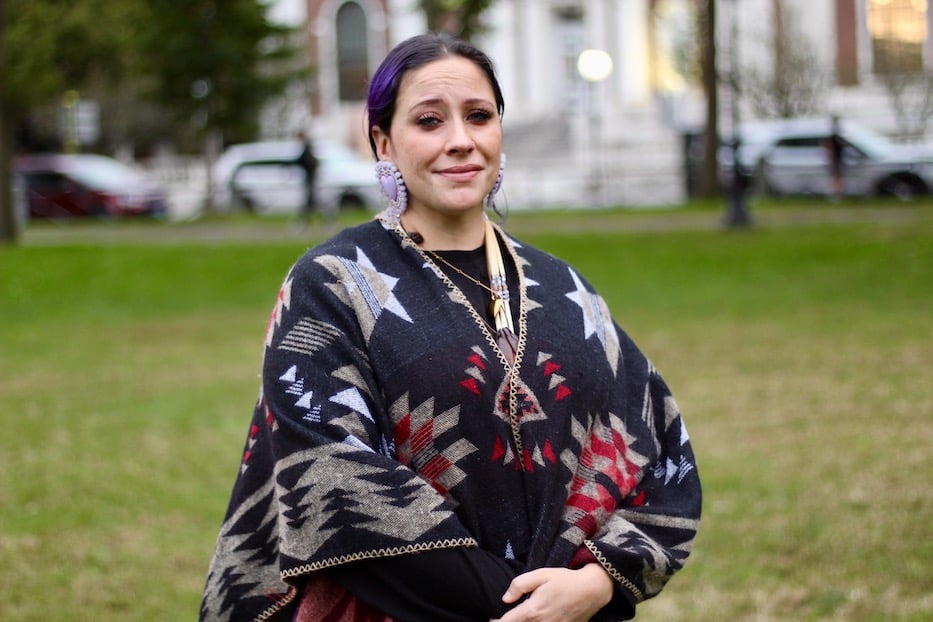
New Havener Rachel Massaro, who is member of the Northern Cheyenne and Saponi tribes.
He explained that some words were painted in orange to bring attention to the history of residential schools, and the horrific separation of children from their families that went on for decades. This year, he said, he feels those aftershocks when he turns on the news or listens to the radio, and sees what is happening to Palestinians in the West Bank and Gaza Strip.
"People call it [Gaza] an outdoor prison, but it's a reservation," he said. "But it's a reservation. That's what it is."
As the Green emptied out, New Havener Rachel Massaro remained for just a moment, letting the cool air and dusk fall around her. A member of the Northern Cheyenne and Saponi tribes, she said that she comes out year after year to both honor her history and create room for future histories.
"I just, I feel like there's no reason to celebrate Columbus, but there is every reason to celebrate Indigenous people," she said. "It's unfortunate that many of us have grandparents that we have to say survived. This is something that we need to fight for generationally."
In her own life, she said, she wants to see more widespread and transparent education around the centuries-long treatment of Native people, land theft, and inhumanity of residential schools in what is now recognized as the U.S.
"I want my kids to know how hard their ancestors fought to be here," she said.
To watch more from Monday's observance, click on the video above.

